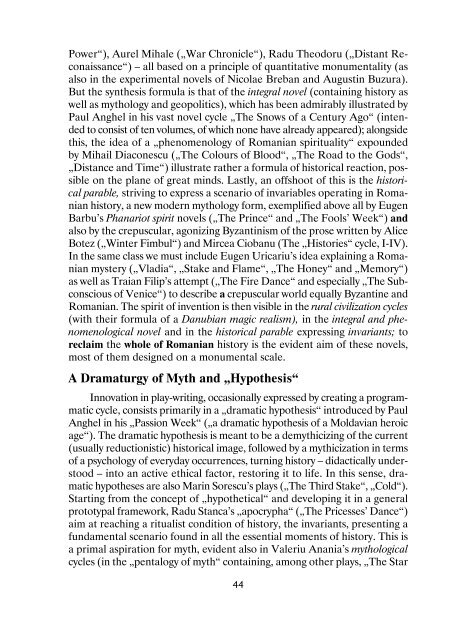PENTAGRAMMA - ROMANIAN LIBRARY
PENTAGRAMMA - ROMANIAN LIBRARY
PENTAGRAMMA - ROMANIAN LIBRARY
You also want an ePaper? Increase the reach of your titles
YUMPU automatically turns print PDFs into web optimized ePapers that Google loves.
Power“), Aurel Mihale („War Chronicle“), Radu Theodoru („Distant Reconaissance“)<br />
– all based on a principle of quantitative monumentality (as<br />
also in the experimental novels of Nicolae Breban and Augustin Buzura).<br />
But the synthesis formula is that of the integral novel (containing history as<br />
well as mythology and geopolitics), which has been admirably illustrated by<br />
Paul Anghel in his vast novel cycle „The Snows of a Century Ago“ (intended<br />
to consist of ten volumes, of which none have already appeared); alongside<br />
this, the idea of a „phenomenology of Romanian spirituality“ expounded<br />
by Mihail Diaconescu („The Colours of Blood“, „The Road to the Gods“,<br />
„Distance and Time“) illustrate rather a formula of historical reaction, possible<br />
on the plane of great minds. Lastly, an offshoot of this is the historical<br />
parable, striving to express a scenario of invariables operating in Romanian<br />
history, a new modern mythology form, exemplified above all by Eugen<br />
Barbu’s Phanariot spirit novels („The Prince“ and „The Fools’ Week“) and<br />
also by the crepuscular, agonizing Byzantinism of the prose written by Alice<br />
Botez („Winter Fimbul“) and Mircea Ciobanu (The „Histories“ cycle, I-IV).<br />
In the same class we must include Eugen Uricariu’s idea explaining a Romanian<br />
mystery („Vladia“, „Stake and Flame“, „The Honey“ and „Memory“)<br />
as well as Traian Filip’s attempt („The Fire Dance“ and especially „The Subconscious<br />
of Venice“) to describe a crepuscular world equally Byzantine and<br />
Romanian. The spirit of invention is then visible in the rural civilization cycles<br />
(with their formula of a Danubian magic realism), in the integral and phenomenological<br />
novel and in the historical parable expressing invariants; to<br />
reclaim the whole of Romanian history is the evident aim of these novels,<br />
most of them designed on a monumental scale.<br />
A Dramaturgy of Myth and „Hypothesis“<br />
Innovation in play-writing, occasionally expressed by creating a programmatic<br />
cycle, consists primarily in a „dramatic hypothesis“ introduced by Paul<br />
Anghel in his „Passion Week“ („a dramatic hypothesis of a Moldavian heroic<br />
age“). The dramatic hypothesis is meant to be a demythicizing of the current<br />
(usually reductionistic) historical image, followed by a mythicization in terms<br />
of a psychology of everyday occurrences, turning history – didactically understood<br />
– into an active ethical factor, restoring it to life. In this sense, dramatic<br />
hypotheses are also Marin Sorescu’s plays („The Third Stake“, „Cold“).<br />
Starting from the concept of „hypothetical“ and developing it in a general<br />
prototypal framework, Radu Stanca’s „apocrypha“ („The Pricesses’ Dance“)<br />
aim at reaching a ritualist condition of history, the invariants, presenting a<br />
fundamental scenario found in all the essential moments of history. This is<br />
a primal aspiration for myth, evident also in Valeriu Anania’s mythological<br />
cycles (in the „pentalogy of myth“ containing, among other plays, „The Star<br />
44



